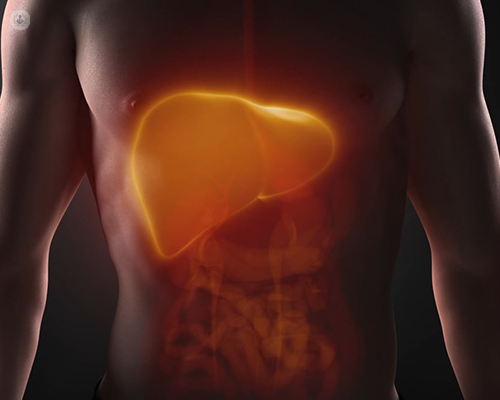Fatty liver disease: A comprehensive insight into its different types
Written by:A build-up of fat in the liver can, of course, be dangerous for our health, as it can lead to conditions such as non-alcoholic fatty liver disease and non-alcoholic steatohepatitis. On hand to provide a detailed, expert analysis of these liver-related conditions is expert gastroenterologist, Professor Shahid Khan.

What is non-alcoholic fatty liver disease?
Non-alcoholic fatty liver disease (NAFLD) is a condition that is characterised by the build-up of excessive fat (also called steatosis or fatty infiltration) within the liver. NAFLD is usually associated with at least one other feature of metabolic syndrome, which itself is a cluster of conditions that frequently occur together. These include increased blood pressure, high blood sugar (typically Type 2 diabetes), excess body fat around the waist, high BMI and abnormal cholesterol or triglyceride levels.
What is the difference between non-alcoholic fatty liver disease and non-alcoholic steatohepatitis?
Non-alcoholic fatty liver disease (NAFL) and non-alcoholic steatohepatitis (NASH) are the two main types of non-alcoholic fatty liver disease. Some liver blood tests may be raised in both. Non-alcoholic fatty liver (NAFL) is a generally benign condition as far as the liver goes. In NAFL, there is no overt liver cell damage if there is fatty infiltration but no actual visible inflammation seen if a liver biopsy were to be done.
Non-alcoholic steatohepatitis (NASH), meanwhile, causes fatty infiltration along with liver inflammation and cell damage. This eventually leads to the deposition of scar tissue in the liver, which can ultimately result in cirrhosis and any of the complications of cirrhosis, including liver failure and liver cancer. Hence, NASH is more dangerous than simple NAFL, and it is generally recommended that patients with NASH be under a regime of regular specialist follow-up.
It is unclear why a minority of patients with non-alcoholic fatty liver disease also then suffer from non-alcoholic steatohepatitis. Theories include other genetic predispositions, as well as contributing factors from other conditions, including the severity of any associated metabolic syndrome.
It is not clear exactly how many people are diagnosed with non-alcoholic steatohepatitis due to the fact that it causes no symptoms. This condition is diagnosed in about five per cent of people in the United States who have a liver biopsy for a variety of reasons.
What is the difference between alcohol-related fatty liver disease and non-alcoholic fatty liver disease?
The excessive consumption of alcohol can also lead to fatty infiltration of the liver. Both alcohol-related fatty liver disease and non-alcoholic fatty liver disease look very similar on imaging scans and even on a liver biopsy. Just like non-alcoholic fatty liver disease, alcohol-related fatty liver disease can cause simple fatty liver only, or significant inflammation and scarring. Patients can experience both alcohol-related fatty liver disease and non-alcoholic fatty liver disease.

How is non-alcoholic steatohepatitis diagnosed?
Non-alcoholic steatohepatitis (NASH) causes no symptoms in the vast majority of cases and is usually discovered incidentally following routine blood tests which often include those that assess liver function. Levels of two liver enzymes, aspartate aminotransferase (AST) and alanine aminotransferase (ALT), are elevated in the vast majority of people suffering from NASH.
However, there are many other causes of raised AST and ALT. Additional tests are therefore required to exclude other types of liver disease, such as viral hepatitis, autoimmune disease and genetic conditions. Imaging tests (including ultrasound, CT scan, or magnetic resonance imaging (MRI) may reveal fat accumulation in the liver.
However, these tests cannot differentiate NASH from other causes of liver disease that have a similar appearance, such as alcohol or drug-related fatty liver. A liver biopsy is sometimes then required in order to confirm the existence of non-alcoholic steatohepatitis if other causes of liver disease cannot be excluded. A liver biopsy is also used to grade the degree of scarring in the liver (fibrosis).
What is the role of fibroscan?
The Fibroscan is a non-invasive test that uses ultrasound waves to determine how stiff the liver is. It does not involve radiation. A measure of the liver’s stiffness is used to estimate how much scarring there is in the liver, as increasing scarring (or fibrosis) causes increased liver stiffness.
Thus, a FibroScan can usually determine if cirrhosis, the most advanced stage of fibrosis, has developed, and can thus be an alternative to liver biopsy for detecting how severe liver scarring has become present. Most modern Fibroscans also have a function to quantify the level of fat in the liver.
How is NASH treated?
There is currently no proven drug therapy shown to reverse NASH, nor the fibrosis NASH can cause. The main treatments are:
- optimising control of any medical conditions associated with it, such as diabetes, high lipids and obesity
- monitoring for progression
Several new drug treatments are currently being evaluated in clinical trials but none are currently in widespread use. Losing weight has been repeatedly shown to help reduce levels of liver enzymes and insulin requirements, and improve quality of life. Weight loss should be gradual and sustainable can be helped if working alongside a healthcare provider or specialist dietician for an individualised weight loss plan. Weight loss will also treat other associated conditions of the metabolic syndrome.
It is generally recommended that people with NASH should avoid drinking alcohol, as it can worsen and/or accelerate liver disease and fibrosis. Some studies suggest people who drink coffee have a lower risk of developing liver scarring, but this is unproven. As with any potential chronic liver disease, people with NASH should be vaccinated to protect themselves from hepatitis A and B if they are not already immune.
Professor Shahid Khan is an expert gastroenterologist and leading consultant physician based in London. Check out his Top Doctor’s profile to book an appointment with him to solve any liver-related medical concerns you may have.


